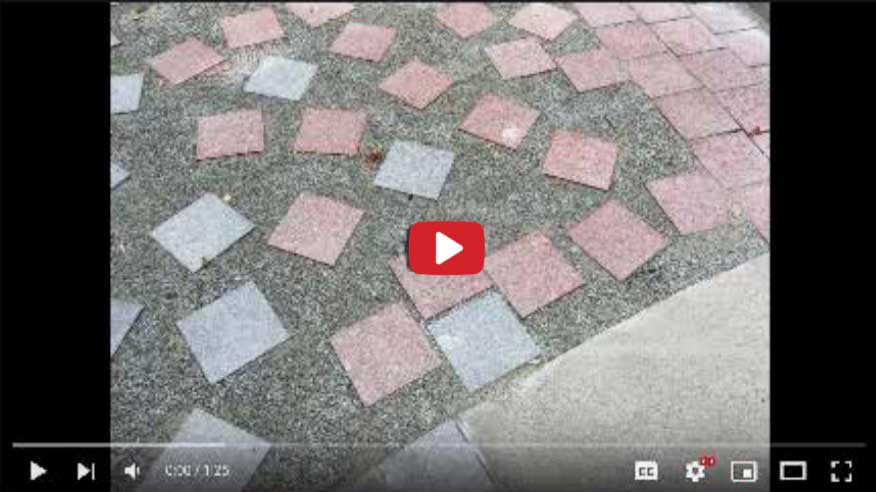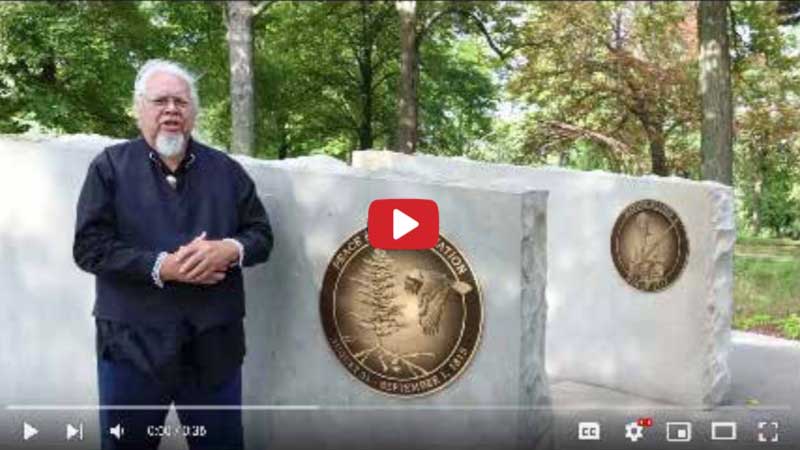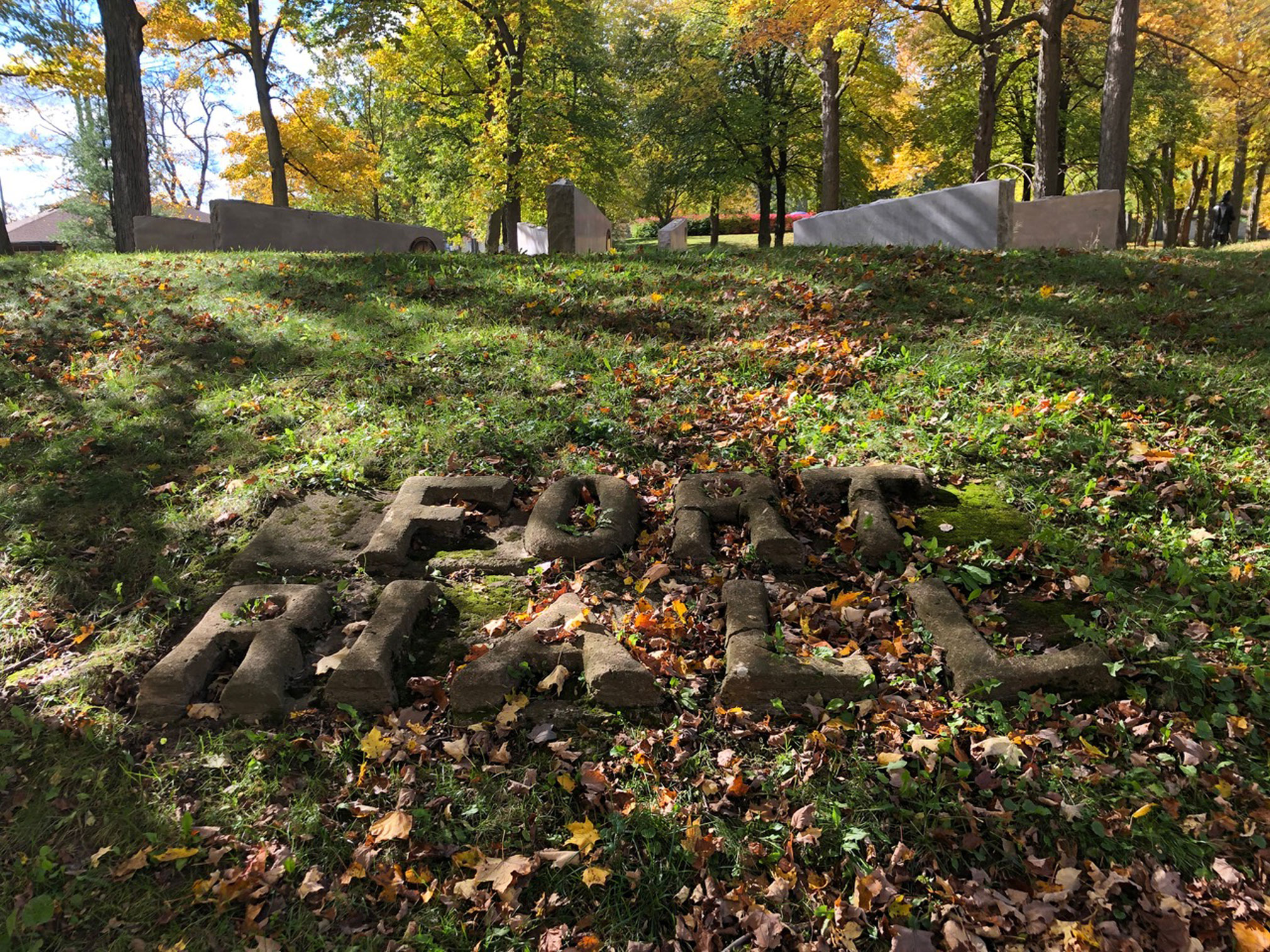1 TURTLE GRANITE STONE MOSAIC: The memorial journey begins with the Turtle, a symbol of the earth for the Haudenosaunee, Anishinaabek, and other Indigenous peoples. The turtle represents the land and the physical creation of North America within Six Nations culture. In their Creation Story, the Mother Earth was created on the back of a giant turtle. In the memorial scheme the turtle form is a focal point of entry to the memorial space, serving as the first element of the en- trance experience and guiding visitors into the exhibition space.
2 NORTON AND BRANT: BRONZE STATUES ON STONE BASES: Two primary figures of the war, John Norton and John Brant, war captains from the Six Nations, serve as sentries at the entrance of the pathway leading to the long- house (the traditional architectural structure of the Six Nations people). John Norton was adopted by the Mohawk Nation and was appointed to be a diplomat and war chief for that nation in 1799. John Brant was the son of the famous Mohawk War Chief Joseph Brant and he became, along with Norton, a leading war chief of the Haudenosaunee during the War of 1812. The Six Nations under Norton and Brant played a key role in the Battle of Queenston Heights and at several important battles during the three-year conflict. Soon after the declaration of War of 1812, Norton and Brant recruited a few hundred Six Nations and allied Native fighters to assist Ma- jor-General Sir Isaac Brock on the Niagara frontier, which was threatened by a large American army at Lewiston. On October 13, 1812, the Americans invaded Canada at Queenston Heights.
John Norton (Teyoninhokarawen)
John Norton (Teyoninhokarawen)
A protégé of Mohawk leader Joseph Brant, Norton became a military leader of Six Nations forces that had allied with Great Britain in the War of 1812. He led a Six Nations contingent into battle during American invasions at Queenston Heights, Stony Creek, and Chippewa, and in other numerous encounters throughout the Niagara Peninsula and other areas
of conflict including at Tippecanoe and Detroit. At Queenston Heights, with less than 200 warriors, Na- tive allies helped repulse the Americans, thereby se- curing an early victory in the war.
(A fascinating historical figure Norton had a Cherokee father and Scottish mother. Educated in Scotland, he joins British military and travels to North America, becomes immersed in Haudenosaunee culture and is adopted into the Mohawk nation.)
John Brant (Ahyouwa’ehs)
John Brant (Ahyouwa’ehs)
The son of Joseph Brant and Catharine Croghan Brant he was born into a strong leadership family of the Mohawk Nation. Born in Brantford, raised in Burlington Bay, and educated in Ancaster and Niagara-on-the-Lake, John Brant was a product of the region who lived in two worlds. Along with John Norton, he led Native forces at the Battle of Queenston Heights. He was made a lieutenant in the Indian Department and was involved in other engagements throughout the War of 1812. A strong advocate for building schools for his people, in 1828 he was appointed resident superintendent for the Six Nations of the Grand River. In 1830 he was elected to the Legislative Assembly of Upper Canada for Haldimand. Around that time his mother also appointed him as a traditional chief, Tekarihoga.
3 LONGHOUSE: Open Corten steel framed structure. The iconic longhouse that straddles the main path represents a third introductory installation at the beginning of the visitor experience. In their own language the Six Nations people refer to themselves as Haudenosaunee, or “People of the Longhouse.” The architectural longhouse structure represents the confederated house of government formed among the original five nations of the Haudenosaunee (Mohawk, Oneida, Onondaga, Cayuga, and Seneca Nations) more than 500 years ago. The Tuscarora Nation, which joined the Confederacy in 1722, became the sixth nation. The longhouse represents the Six Nations as one large family, living under one law, speaking with one voice, and united as one mind.
Play Video

4 TWO ROW WAMPUM BELT PATHWAY:
Granite pavers with natural stone colours. The Two Row Wampum Belt (Aterihwihsón:sera Kaswénta) emerged from the metaphoric diplomatic language used by the Haudenosaunee in meeting with Europeans in the early seventeenth century, and embodies the principals of all subsequent treaties made between the Haudenosaunee and other governments. The Two Row Wampum Belt is a visual instrument that was made with two parallel rows of purple shell wampum beads on a bed of white wampum beads, which represent the river of life upon which we all journey together. The two separate rows of purple beads represent the Indigenous canoe floating alongside the settler’s ship, neither trying to steer the other’s vessel. Between the two rows of purple beads, are three rows of white beads. These were made to stand for the Friendship, Good Minds, and Peace that result from this kind of relationship. As much as the three rows keep the two nations sepa- rate, it also binds them together. This feature connects and organizes all other elements that are arrayed along the length of the pathway.
5 TIME MARKERS
The design contains references to the passage of time in the form of flat linear cast markers intersecting the main path along its length. The timelines are markers of important events in the journey of the War of 1812 and upon Six Nations and Native allies. The 1812 marker indicates the time that the United States declared war upon Great Britain. Across the pathway is a symbolic marker showing weapons of war, the war club and tomahawk. The 1815 marker indicates the end of the war and the time when Haudenosaunee people, who had divided loyalties during the war and ended up fighting and killing each other, came together to negotiate and restore peace among themselves. Across the pathway is a marker symbolizing the Hiawatha wampum belt, the symbol of unity that had formed the peace establishing the original Haudenosaunee confederacy.
6 SYMBOLIC SQUARES Granite blocks with natural red and blue colours. The Battle of Queenston Heights is depicted by an interpretive display featuring an assembly of red and blue squares located adjacent to the main Memory Circle. The red and blue squares serve as symbols for all combatants (identified only by political alliance) who fought and gave their last full measure upon this hallowed ground. The red squares represent the British and their allies. The blue squares represent the Americans and their allies.
Play Video

7 MEMORY CIRCLE: Paved circle with eight radiating 400-million-year-old Queenston limestone memorial walls and centre feature, that when viewed from above shows a radiating starburst design. The circle symbol represents a key spiritual element in many Indigenous cultures and the Memory Circle of the memorial represents the main destination point and reflection and honouring area of the installation. It serves to focus visitor attention on the sacrifice and valor of the Indigenous warriors who fought in the Battle of Queenston Heights and throughout the War of 1812. Upon each of the stone walls is mounted a bronze medallion of plaque. Six walls feature images of chiefs representing the six Haudenosaunee nations, each wearing their nation’s distinctive headdresses called a Gustoweh. This exhibit feature also reveals the commonly known names of their nations, the names in their own languages, and the translations of those names.
Mohawk — Kanien’keha:ka — People of the great flint
Oneida — Onayotekaono — People of standing stone
Onondaga — Onondagega — People of the hills
Cayuga — Guyohkohnyoh — People of the great swamp
Seneca — Onondowahgah — People of the great hill
Tuscarora — Ska-Ruh-Reh — Hemp gatherers
The seventh wall holds a medallion reflecting the peace and reconciliation council that was held on August 31 and September 1, 1815 at the historic Indian Council House site in Niagara-on-the-Lake. And the eighth wall holds two bronze pieces, the first being a medallion that honours Native Allies and the second is a plaque featuring a list of the Indigenous allied nations. As a feature the Memory Circle is well integrated into the site and functions as a “place” as opposed to a singular memorial object. It also functions as part of a living landscape by featuring indigenous plant species, such as sweetgrass within the Corten steel centre circle, and a mix of indigenous plants around the walls. The centre of the circle is the feature that creates a symbolic gathering place for all visitors and serves as the focal point for a variety of events and ceremonies. Each year for example, an annual Indigenous veteran’s ceremony called Valour & Victory is held in November.
PLAY VIDEOS



LIVING STONE – LIVING MEMORIAL
The ceremonial Memory Circle at the center of the memorial features eight limestone walls excavated from the nearby Queenston Quarry. Comprised almost entirely of marine sediments of the crinoid, an ancient sea creature, the limestone began to solidify under pressure some 400 million years ago.
About 12,500 years ago, as the last ice receded northward from Niagara, the geologic feature of the Niagara Escarpment re-emerged. The rock, when freshly broken, was a steely grey and the crystal faces of the stone’s components brought the stone alive. The crinoids have returned, somewhat changed in chemical composition, but still retaining all of their presence. Peering into the polished limestone walls is like looking back in time to when life, as eloquently expressed in the Iroquois creation story, was blossoming on the planet. The heart of the memorial has its origins in life.
8 FORT RIALL: The main path branches into a secondary circular route as it reaches the area of Fort Riall, a horseshoe-shaped earthen mound redoubt artillery battery built during the War of 1812 and named after Major General Phineas Riall. The core of the Landscape of Nations Commemorative Memorial is positioned within the embrace of Fort Riall, blending a historic structure with a contemporary public artwork.
9 ANCESTRAL LANDS: Earthen berms were installed to balance out the redoubt artillery battery of Fort Riall. The main path meanders past a series of seven berms that represent the ancestral lands of Six Nations and Native allies, taking into account the cultural concept of basing decisions upon considering the interests of seven generations yet to come. When Europeans first arrived in North America, the Haudenosaunee were based in what is now the northeastern United States, primarily in what is referred to today as upstate New York, extending west of the Hudson River and across the Finger Lakes region. Each mound is planted with Indigenous vegetation.
10 ENVIRONMENT
Low maintenance native plant species. The designed landscape and natural environment of indigenous trees and grasses serve as a contrast to the more common and formal botanical planting approach visible within the Niagara region. The original environment of the memorial site was much different than it is today. The Landscape of Nations design reflects traditional landscapes through the planting of native grasses that would have been found in the area at the time of the battle. The environment of the memorial site landscape is designed to minimize maintenance and ensure its sustainability. This is done to honor the Mother Earth upon which we all walk.
TRADITIONAL PLANTS
The centre circle would be planted with sweetgrass (hierochloe odorata). The sweetgrass would grow without maintenance and would provide a blanket of ground cover. Sweetgrass is a hardy perennial native to North America. The leaves do not have rigid stems, so only grow to about 20 cm (7.9 in) in height, and then leaves grow outward horizontally to 100 cm (39 in) or more, by late summer. There are several strains of sweetgrass — a regular strain that can be harvested once or twice a year, and a naturally occurring polyploid strain, which is much faster growing and can be harvested three to five times a year. The grass planted here could be harvested for various ceremonial or functional uses as desired.
11 TREE OF PEACE: Living white pine tree with four symbolic white roots radiating from its base. The journey ends at the living Tree of Peace, the Six Nations symbol of peace and unity. Weapons would be symbolically buried under the tree to seal a peace agreement. An eastern white pine was the symbol of the Iroquois constitution known as the Kaianere’kó:wa, or Great Law of Peace. Its characteristic bundles of five needles became the symbol of the original Five Nations joined together as one. According to Haudenosaunee tradition, the Great Law of Peace ended the ancient cycle of enmity and continuous conflict between the separate nations of the original five nations, and united them into the Haudenosaunee Confederacy, the most powerful force in North America until the rapid expansion of European colonization in the 18th century. In this way, the memorial concludes by honoring the peace that was established more than five centuries ago by the revered Six Nations culture figure, the Peacemaker. This ancient peace, severely threatened by the War of 1812, needed to be restored among Six Nations people who had fought against each other.
PLAY VIDEO





